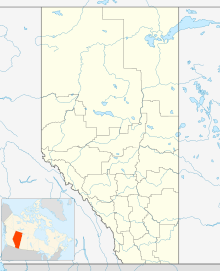Mînî Thnî facts for kids
Quick facts for kids
Mînî Thnî
Morley
|
|
|---|---|
|
First Nations settlement
|
|
| Country | Canada |
| Province | Alberta |
| Census division | No. 15 |
| Municipal district | Municipal District of Bighorn No. 8 |
| Government | |
| • Type | Unincorporated |
| Elevation | 1,240 m (4,070 ft) |
| Time zone | UTC−7 (MST) |
| • Summer (DST) | UTC−6 (MDT) |
Mînî Thnî, once known as Morley, is a First Nations community in southern Alberta, Canada. It is located on the Stoney 142/143/144 Indian reserve. The community sits near the Canadian Pacific Kansas City railway, between the Trans-Canada Highway and the Bow River. It is also upstream from Ghost Lake.
Mînî Thnî is part of the Stoney Nation. It is about 1,240 metres (4,068 feet) above sea level.
A historic building, the McDougall Memorial United Church, is a few miles from Mînî Thnî. Built in 1875, it was one of the oldest churches in southern Alberta. It was damaged by fire in 2017, but restoration work is almost finished. This church was part of Morleyville, which was the first pioneer settlement in southern Alberta. Morleyville was founded by the Methodist missionary George McDougall and his sons.
Morleyville existed until 1921. A new church was then built in the current Mînî Thnî community. The old church is now a provincial historic site. Other important events in Mînî Thnî's history include Canada's first airport in 1920. Also, in 1969, the first court on First Nations land was held here.
Contents
Exploring Mînî Thnî's Past
Early Beginnings
The Mînî Thnî area was first settled by First Nations people. In 1873, the Methodist missionary John McDougall and his wife arrived. They came to set up a mission in the Bow Valley. Their goal was to connect with the Nakoda (Stoney) and Siksika (Blackfoot) First Nations. John's father, George McDougall, asked them to start this mission.
John chose a site first called Ghost River. He later renamed it Morleyville. This name honored his friend Morley Punshon, a doctor from Ontario.
Building the Community
John McDougall and his wife started by building a small log house. They also built a small church. Soon after, they moved their mission closer to the river. In 1875, they built a larger church. George McDougall and Andrew Sibbald, a carpenter, helped them. They used logs and boards from local trees.
The church had one room. Its outside walls were left unfinished, but the inside was painted white. Around 1900, the log walls were covered with siding, and a steeple was added. This church is the oldest Protestant church still standing in southern Alberta. It is also the oldest building in the Bow Valley.
Morleyville: A Pioneer Hub
David McDougall, John's brother, later joined him at Morleyville. He helped start the Indian Trading Post. About seven hundred First Nations people visited the post. They would barter animal skins for food and blankets. The homes and trading post were protected by a fence of heavy logs. This was to defend against any attacks.
Morleyville became a busy place for settlers coming to the Bow Valley. At its busiest, over two hundred people lived there. It was southern Alberta's first pioneer settlement. A school and an orphanage were built. There were also homes for missionaries, barns, and corrals. The first herd of breeding cattle in southern Alberta provided meat and milk. Andrew Sibbald, one of Alberta's first trained teachers, taught at the school.
An Indian residential school was operated by the Methodists in Mînî Thnî. It was open from 1886 until 1949.
Changes and Restoration
Morleyville's importance decreased in the 1880s. This happened when the Canadian Pacific transcontinental railroad was built on the opposite side of the Bow River. John McDougall and his wife stayed until they retired in 1898. The old church was used until 1921. Then, a new church was built a few miles away. This new church was in the First Nations settlement that grew around an Indian Agency building. This newer settlement is today's Mînî Thnî.
The old settlement and its church were left empty for a while. Then, volunteers from the United Church of Canada formed a group to restore it. The work was finished in 1952. The restored church is still used for weddings and special events. It has been named a provincial historic site. The McDougall Stoney Mission Society takes care of the church. They also look after the surrounding land, which is an important natural area.
Modern Milestones
In 1920, Canada's Air Board opened its first airport and test station in Mînî Thnî. It was called the Morley Air Station. It had airplanes used for looking over Banff National Park. They also helped with forestry ranging in the Rocky Mountain Foothills and aerial firefighting.
In 1969, Mînî Thnî made history again. It hosted the first court in Canada to be held in a building owned by a First Nation, on First Nations land.
Notable People
- John W. Niddrie, an early pioneer and religious leader.


